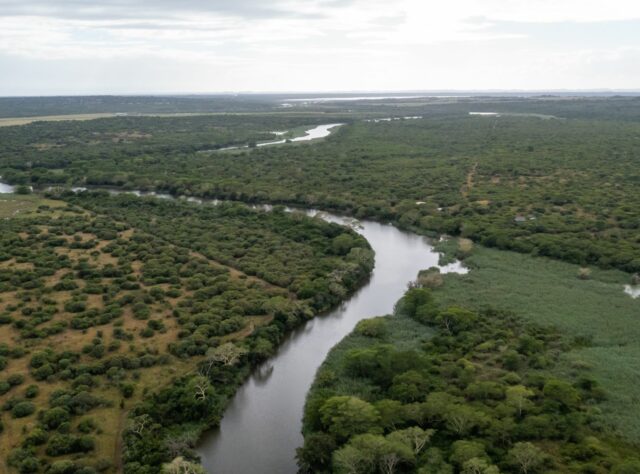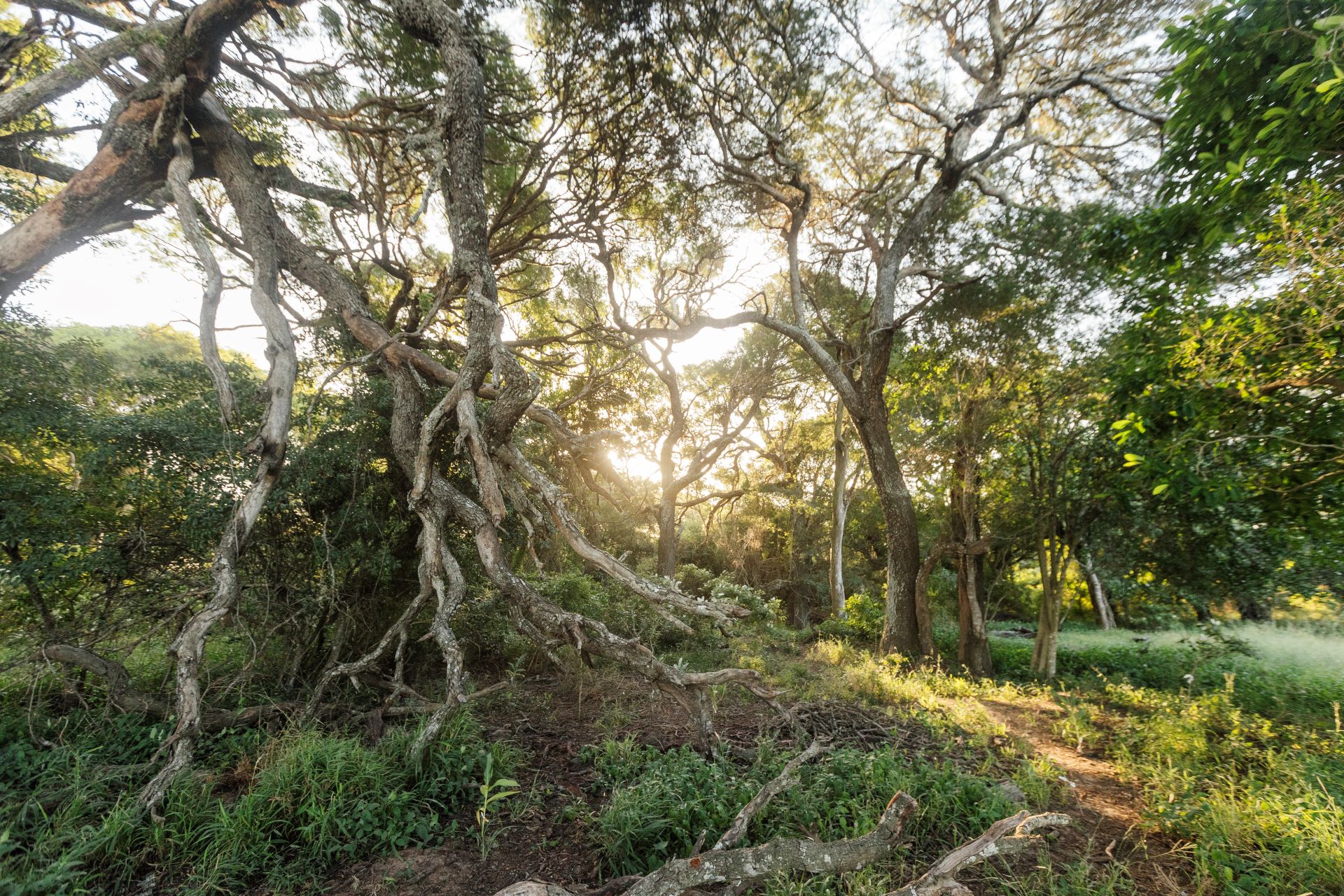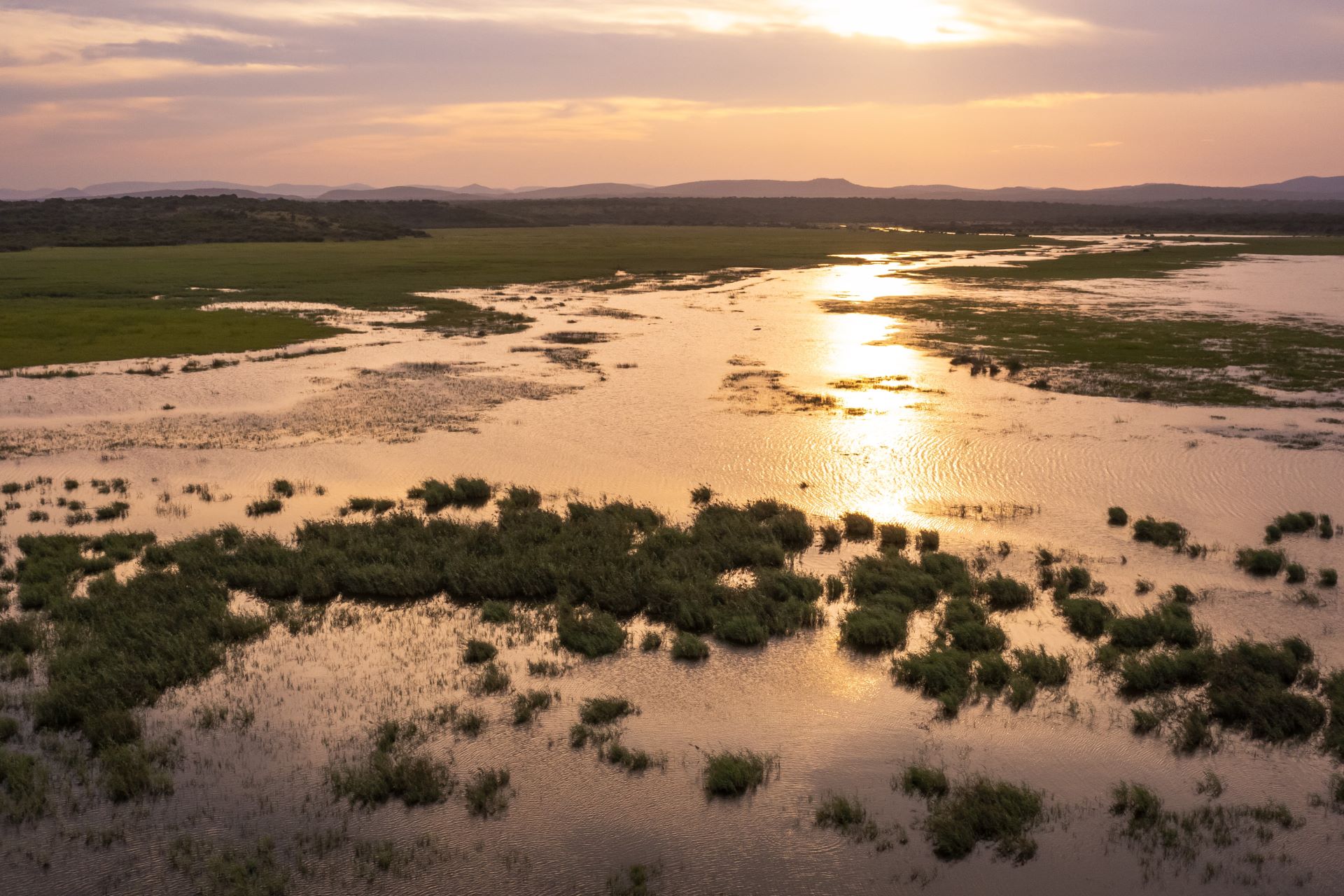
An aerial image showing the diversity of habitats around the Greater Ukuwela Nature Reserve. Credit: Chantelle Melzer
This spring, you can help our partner Wild Tomorrow connect and expand the Greater Ukuwela Nature Reserve (GUNR) with our appeal Connecting Ukuwela.
This reserve is incredibly special in many ways but perhaps above all because it is so unlike what you might expect. When you picture an African landscape, you probably imagine a vast savanna, brought alive by prides of Lion (Panthera leo) and herds of African Elephant (Loxodonta africana) and migrating Wildebeest (Connochaetes gnou). But the reality is often far richer and more complex. The GUNR is a prime example of this, home to a very rich and varied tapestry of habitats. A tapestry which includes mystical Fever Tree Forests, Dry Sand Forests, and lush wetland oases.
Dry Sand Forest: a place like no other
Dry Sand Forests are a very rare forest ecosystem that is only found in South Africa and Mozambique. They grow on the isolated remnants of sand dunes that were left behind several million years ago as the coastline receded eastwards to its current position. Their unusual sandy soils are also nutrient poor because Termites rapidly snatch up any fallen leaf litter from the forest floor, thus leaving it very bare.
Unlike other forests, you will therefore not find a dense layer of undergrowth here, nor many ferns or mosses, but rather a wealth of uniquely adapted species. Many of the plants, for example, are extremely slow growing to cope with the nutrient-poor soils. These include the majestic and ancient Lebombo Wattle (Newtonia hildebrandtii), which grows at a rate of 1-2 mm a year and can live to 1500 years old. Despite their slow growth, they eventually become the giants of the Dry Sand Forest, dominating the canopy and providing homes and food for over 100 different species. High up in a Lembobo Wattle’s crown, for instance, you might glimpse the brilliant flash of a Neergaard’s Sunbird (Cinnyris neergaardi) or the delicate white flowers of the Cyrtorchis praetermissa orchid. Far above the forest floor, this orchid is making the most of the canopy sunlight. Meanwhile, far below on the Wattle’s lower branches, you will likely find Pinhead Orchids (Microcoelia exilis). These fascinating plants are leafless and instead photosynthesise through their roots, which dangle in the air below them.

The “mother tree” of the Dry Sand Forest: Lebombo Wattle. Credit: Chantelle Melzer
In many ways, Dry Sand Forest defies our expectations of what a forest should be. Its most unusual feature, however, is not within the forest itself but rather just outside of it. These forests are often surrounded by a 1-2-metre-wide strip of bare soil which acts as a firebreak. Remarkably, Dry Sand Forest appears to protect itself from surrounding savanna fires.
While Dry Sand Forest may be able to protect itself from fire, it is still a fragile habitat and very vulnerable to human activity. In the last 20 years alone, over 70% of the world’s sand forest was destroyed to make way for agriculture and timber. Today, sand forests are classified as critically endangered. Our partner Wild Tomorrow’s GUNR is home to 18 hectares (44.5 acres) of Dry Sand Forest, which they are protecting and expanding through the planting of 10,000 sand forest trees.

Wild Tomorrow is actively restoring the precious Dry Sand Forest found on the GUNR. Credit: Chantelle Melzer
The fairy-tale world of Fever Tree Forests
The GUNR is also home to Fever Tree Forests. These are magical places, perhaps best described by Wild Tomorrow’s co-founder John Steward: “When you’re driving around our property you pass through grasslands, you pass through lower-level bush, but then you hit those Fever Trees and you are suddenly in a different world. It feels very African, but also very fairy-tale.”

Entering the fairy-tale world of Fever Trees. Credit: Chantelle Melzer
Fever Trees (Vachellia xanthophloea) are beautiful plants, tall and slender with feathery green leaves, branches protected by straight white thorns, and unusual yellowish-green bark that softly glows in the sunlight. They are as rapid in their growth as the Lebombo Wattle is slow. The epitome of “live fast, die young”, they can grow 1.5 metres a year and often “kill off” their younger branches, in a process called sacrificial branching, to avoid wasting energy in their rush skywards.
Despite having short lifespans, they nonetheless provide habitat and food for many species. African Elephants and Giraffe (Giraffa sp.), for instance, eat its branches and leaves, while Vervet Monkeys (Chlorocebus pygerythrus) feed on the seed pods. Birds, meanwhile, nest in their branches, where their thorns help ward off chick-hunting snakes. These include the finch-like Pink-throated Twinspot (Hypargos margaritatus), distinguished by the pink throats of males and the remarkable Polka-dot plumage of both sexes.
A rich watery oasis
The Msinene River flows along the northern border of the GUNR, creating six hectares (14.8 acres) of marshy habitat. These wetlands are very important breeding and nursery sites for innumerable fish, frogs, reptiles, and birds. Lake St. Lucia, for example, which the Ukuwela Reserve adjoins and extends, is one of only three breeding sites in South Africa for the Great White Pelican (Pelecanus onocrotalus). Although still classified globally as Least Concern, its populations have declined in South Africa. Half of South Africa’s original wetlands have been degraded or destroyed and 48% of its remaining wetlands are now classified as Critically Endangered. In light of this threat, every protected hectare counts.

A view across the wetlands on Greater Ukuwela Nature Reserve’s northern border. Credit: Chantelle Melzer
With dedication and expertise, life can be breathed back into these degraded wetlands. For example, our partner Wild Tomorrow has removed dense clumps of non-native Castor Oil plants (Ricinus communis) from GUNR’s riverbanks. Eight-feet tall, these were previously preventing Nile Crocodiles (Crocodylus niloticus) from clambering up onto the banks to make nests and lay their eggs. This has made a wonderful difference, with dozens of successful hatchings since their removal.
Restoring the tapestry
The tapestry of habitats found within the GUNR, and KwaZulu-Natal more broadly, makes this region globally important for biodiversity. It falls within the Maputaland-Pondoland-Albany Biodiversity Hotspot and is a priority for conservation. This is why our partner Wild Tomorrow is currently working to purchase a critical piece of land that will enable them to further connect, enlarge, and restore these habitats.
Together, we can protect the remarkable tapestry of habitats found at the Greater Ukuwela Nature Reserve. Learn more about our Connecting Ukuwela appeal, and how you can help, here.

